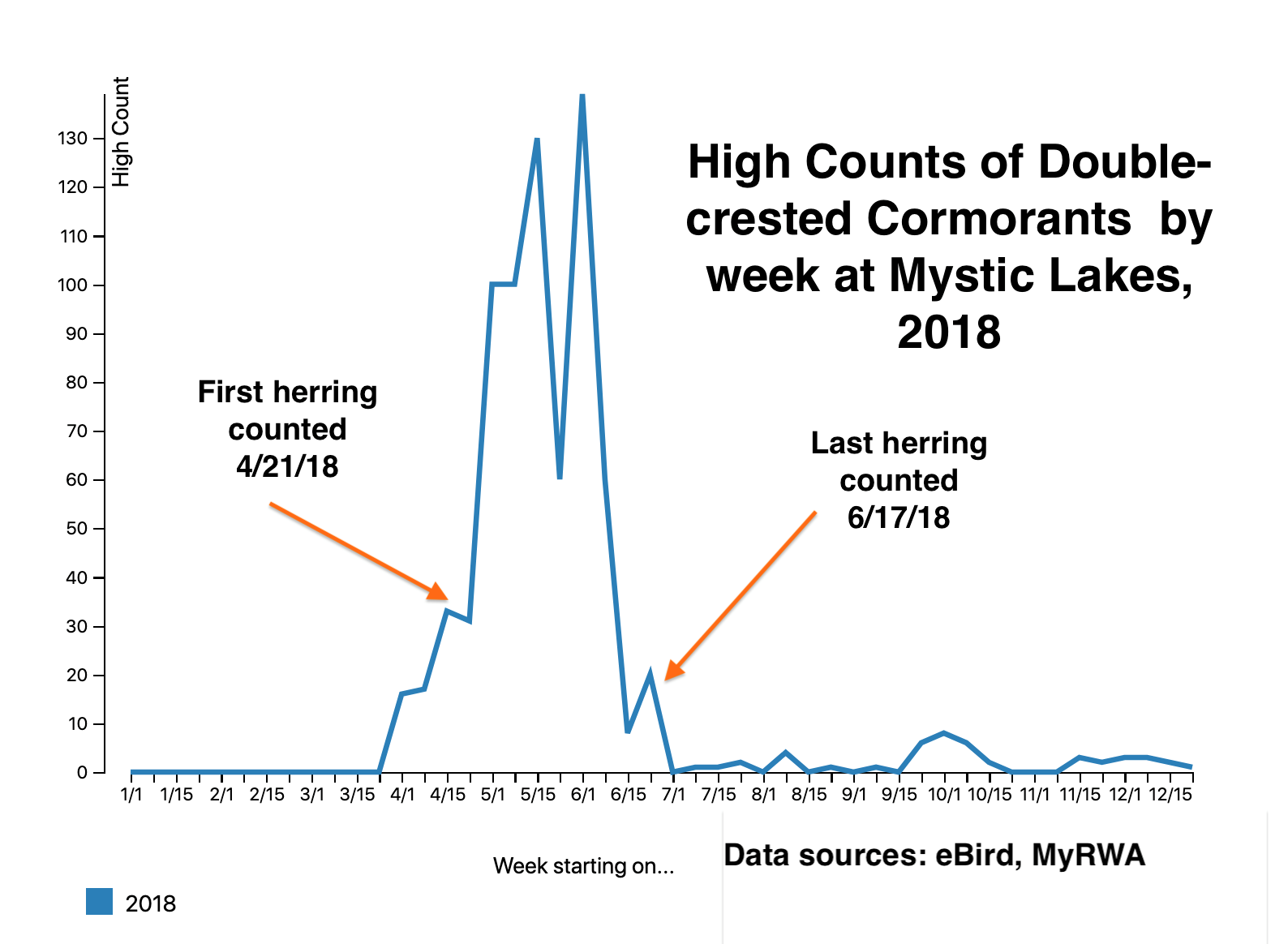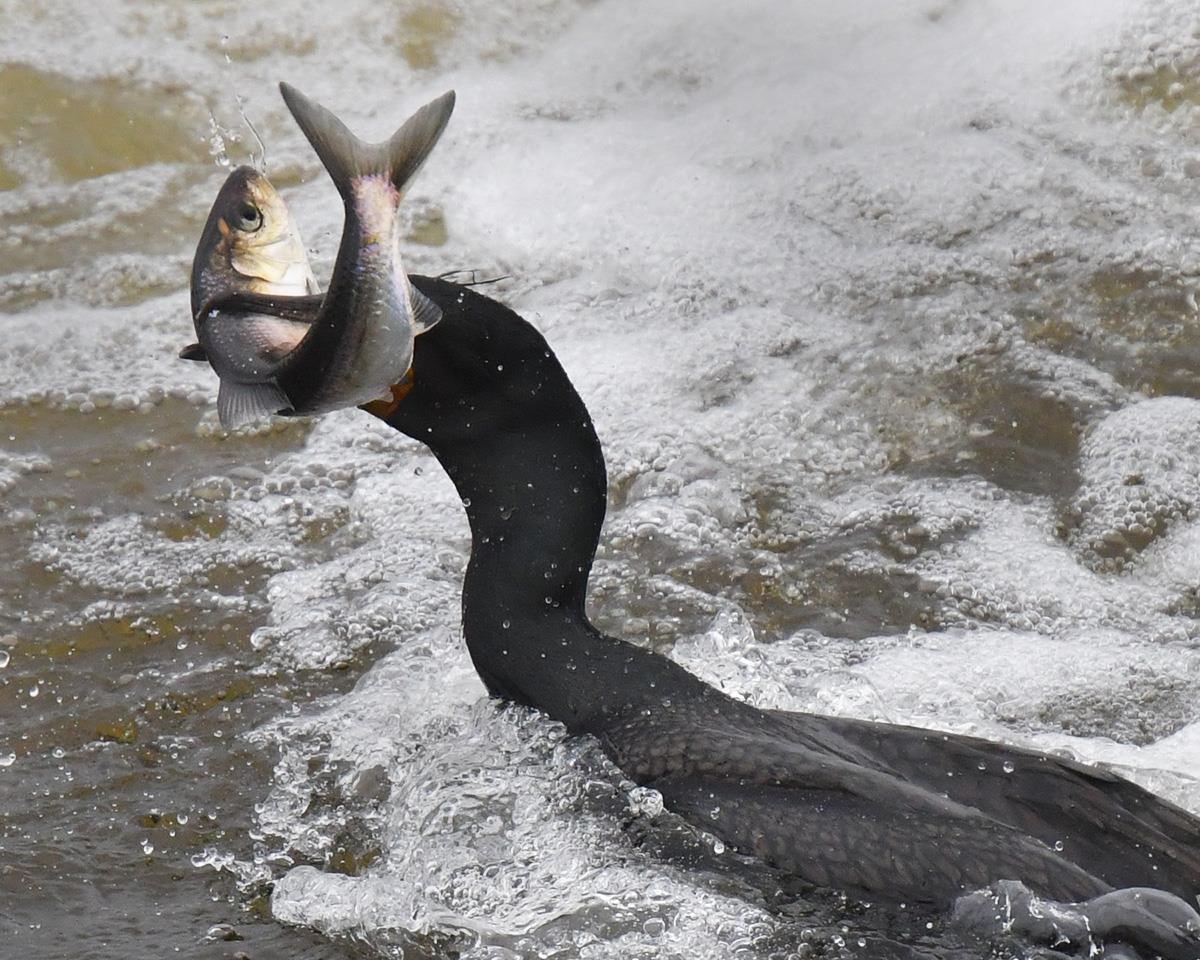The annual river herring run has started in the Mystic River-with the first fish spotted on April 18, 2019 at the Mystic Lakes Dam in Medford. Listed as one of the largest in the Commonwealth—river herring travel from the Atlantic Ocean into Boston Harbor and up the Mystic River to Mystic Lakes and Horn Pond to spawn.
This migration is an important part of the both the local and oceanic food web. Locally, the large influx of birds during the herring migration clearly shows this interdependence on this food chain. Data from eBird, a Cornell University citizen science project, shows that Double-crested Cormorants—diving birds that hunt for fish—are present at the Mystic Lakes Dam almost exclusively during the herring run (see graph below).
“It is not just Cormorants that depend on the herring migration, said Andy Hrycyna, Watershed Scientists. “When the fish arrive, so do birds that like to eat them, from Great Blue Herons, to Black-crowned Night-herons, to Herring Gulls. It is a great time for birders in the Mystic River watershed, and of course for all the birds who depend on the river herring.”
Pictured to the Left: A Double-crested Cormorant capturing a herring at Mystic Lakes Dam. The Cormorants arrive at Upper Mystic Lake with the herring around mid-April and stay in large numbers (often more than 100 at a time) until mid-June. Photo Credit: Joe Brown | https://www.joebrownphotos.com/
“As a local nature photographer, I’ve discovered that the Mystic River Watershed is an amazing habitat for a myriad of creatures and offers photographic opportunities every day of the year! I think quite possibly the herring-run time of the year is my favors as it’s really a challenge to get the Cormorants, Night-herons or even the gulls consuming the herring. In this day of computers and cell phones, I encourage everyone to get outside and enjoy the natural habitat the watershed area provides. See you out there,” said Joe Brown, Joe Brown Photography.
In addition to the birds and fish though that are back on the Mystic--180 plus volunteers are part of the Mystic River Watershed Association’s robust monitoring program. For 2019, there are monitoring programs in Mystic Lakes, Arlington, which has been a site since 2012, and Horn Pond, Woburn, which was added this year. Volunteers count herring for 10 minutes every hour for the entire migration (approximately 10 weeks ending in mid-June). This data is used by the Division of Marine Fisheries to estimate the annual run size, which has tripled in size since 2012.
When we asked some of our new and returning monitors why they participate in this program, this is what they said:
“I am an avid fisherman and recognize the importance of herring in the watershed. I’m excited to be part of the science of monitoring the lakes and pond,” said Travis Filter, a Horn Pond herring monitor from Medford.
“It is awe inspiring to watch the herring make a journey that is just imprinted in their DNA, said Linda Arnow,” a Mystic Lakes herring monitor from Lexington.
“Watching the numbers grow every year!” said Leonore Eforo, a monitor at the Mystic Lakes from Medford. “And being around other people who care so much about this effort. Especially those of us who are old enough to remember how dirty the river was...what a joy to witness the change. Thank you Mystic River Watershed Association!”
Where to see the migration?
When the run is at its peak—often in late May or early June—you can see herring in the water. A map of the best spots to see river herring and the birds that depend on them is here: https://www.mysticherring.org/resources.
Want to be a Citizen Scientist?
Beyond the in-person monitoring, the Mystic River Watershed Association also has an underwater “fish cam” and counting platform so that citizen scientists can help use document this migration using their computer. The data provided by online and in-person monitors provided needed data to both estimate the run size and to also learn more about this keystone species to aid in recovery and restoration efforts. Count fish here: www.MysticHerring.org.
Want to help the Herring?
Join us at the Herring Run & Paddle on May 18, 2019 at Blessing of the Bay in Somerville to raise money to help protect and restore this river. Register here.



